NCERT Solutions for Class 7 English Unit 4 Travel
| Table of contents |

|
| Let us do these activities before we read (Page 157) |

|
| Let us discuss (Page 161) |

|
| Let us think and reflect (Page 162) |

|
| Let us learn (Page 163) |

|
| Let us write (Page 165) |

|
Let us do these activities before we read (Page 157)
QI: Complete the following word web on travel.
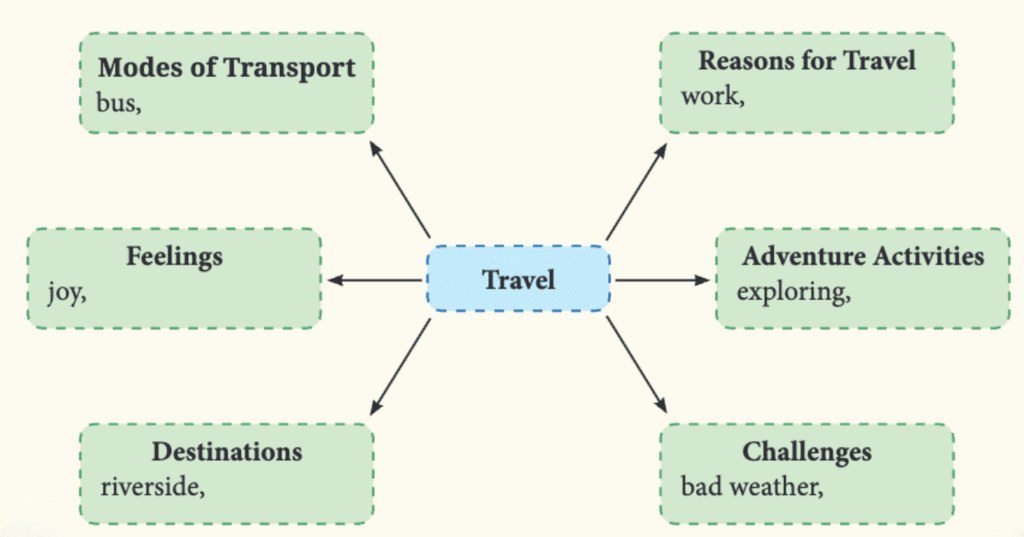
Ans:
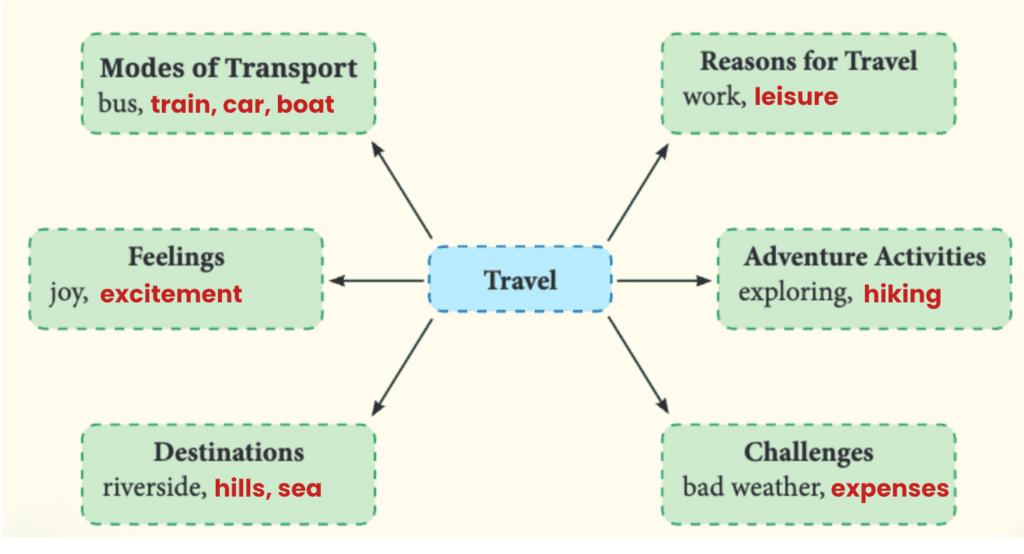
QII: You are going on a trip to an adventure camp with your classmates and teacher.
1: How will you travel to the adventure camp?
Ans: I will travel to the adventure camp by bus with my classmates and teacher.
2: What things will you take along?
Ans: I will take a water bottle, snacks, a backpack, comfortable clothes, and a camera.
3: Why would you like to go there?
Ans: I would like to go there to have fun, try new activities, and spend time with my friends.
4: What are the activities you would like to do with your friends?
Ans: I would like to do trekking, rope climbing, and campfire storytelling with my friends.
5: How much time will it take to complete your adventure trip?
Ans: The adventure trip will take about 3 days to complete.
QIII: Discuss in pairs. What might be the reasons that people enjoy train journeys?
Ans: People enjoy train journeys because:
- They can see beautiful views like mountains and rivers.
- It’s relaxing to sit and watch the scenery.
- They can talk and play with friends or family.
- Trains are comfortable and have space to move around.
Let us discuss (Page 161)
QI: The main ideas of each stanza of the poem are given below. Write the number of the stanza against the matching main idea.
1. At night, the speaker imagines the train and hears its engine in the quiet
Ans: Stanza 2
2. The speaker feels a strong desire to take any train, no matter where it goes
Ans: Stanza 3
3. The speaker hears the train whistle during the day, even though the train is far away
Ans: Stanza 1
QII: Read the poem and underline the rhyming words in each stanza. Write the rhyming words from each stanza. An example has been done for you.
1. Stanza (i)
Ans: away-day; speaking-shrieking
2. Stanza (ii)
Ans: by-sky; dreaming-steaming
3. Stanza (iii)
Ans: make-take; knowing-going
QIII: Identify the rhyme scheme of the poem from the options given below.
1. AABB
2. ABCA
3. ABAB
4. ABBC
Ans: 1. AABB
QIV: Identify the word in the poem that personifies the whistle of the train.
Ans: shrieking
QV: Tone refers to the attitude the poet has about the poem. Which of these words can be used to describe the poet's tone in this poem? Ans: excited; curious; enthusiastic; joyful
Ans: excited; curious; enthusiastic; joyful
QVI: Select the words that tell us what the train symbolises for the poet.
1. education
2. adventure
3. comfort
4. opportunities
Ans: 2. adventure
QVII: Complete the following by choosing the correct option from those given in brackets.
The poet repeats the line, ‘...there isn’t a train goes by,’ in all three stanzas to _______. (highlight the speaker’s fascination with the train/suggest that the area has many trains passing through)
Ans: The poet repeats the line, '...there isn't a train goes by,' in all three stanzas to highlight the speaker's fascination with the train.
QVIII: The poem contrasts the busy day with the stillness of the night. What is the common factor in these?
Ans: The common factor is the speaker's thoughts about the train in both day and night.
QIX: Imagery is a literary device that uses descriptive language to create mental pictures and appeal to the reader's senses (sight, sound, smell, taste and touch). It makes the descriptions more relatable. Select the phrases from the poem that are examples of imagery.
Ans: - day is loud
- whistle shrieking
- cinders red on the sky
- engine steaming
Let us think and reflect (Page 162)
QI. Read the extract given below and answer the questions that follow.
1. My heart is warm with the friends I make,
And better friends I’ll not be knowing...
(i): Choose the suitable option to complete the following.
The line 'My heart is warm' refers to a heart that is _____
A. filled with worries
B. full of love
C. feeling upset
D. experiencing anger
Ans: B. full of love
(ii): What does the speaker say about her current friends?
Ans: The speaker says she makes friends who make her heart warm.
(iii): What does the line 'better friends I'll not be knowing' suggest about the speaker's feelings toward their current friends?
Ans: It suggests the speaker feels her current friends are the best and she won’t find better ones.
(iv): Complete the following suitably.
The tone of the speaker in these lines is ______ (grateful/content)
Ans: The tone of the speaker in these lines is content.
QII. Answer the following questions.
1: What does the phrase 'cinders red on the sky' tell us about the train at night?
Ans: It tells us the train’s sparks light up the night sky like red cinders.
2: What is the significance of the repeated references to the train's whistle?
Ans: The train’s whistle shows the speaker’s strong fascination with trains and travel.
3: What does the line 'no matter where it's going' reveal about the speaker's attitude towards travel?
Ans: It reveals the speaker loves travel and adventure so much that she doesn’t care about the destination.
4: Do you think the poet actually sees and hears the train? Why or why not?
Ans: No, the poet doesn’t actually see or hear the train because the train is miles away, and she imagines its sounds and sights.
Let us learn (Page 163)
QI: Read the expressions from the poem given in Column 1 and match them with what they indicate in Column 2.
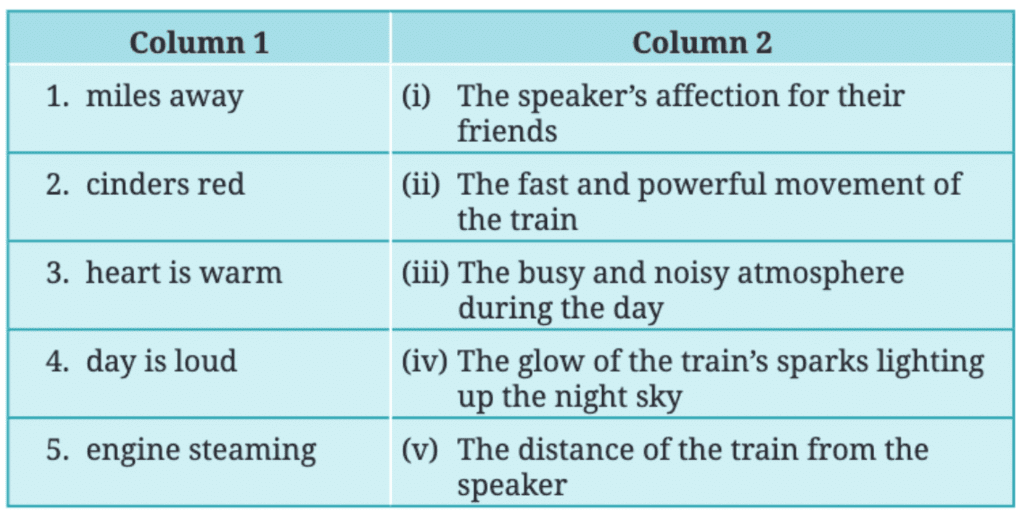 Ans:
Ans: 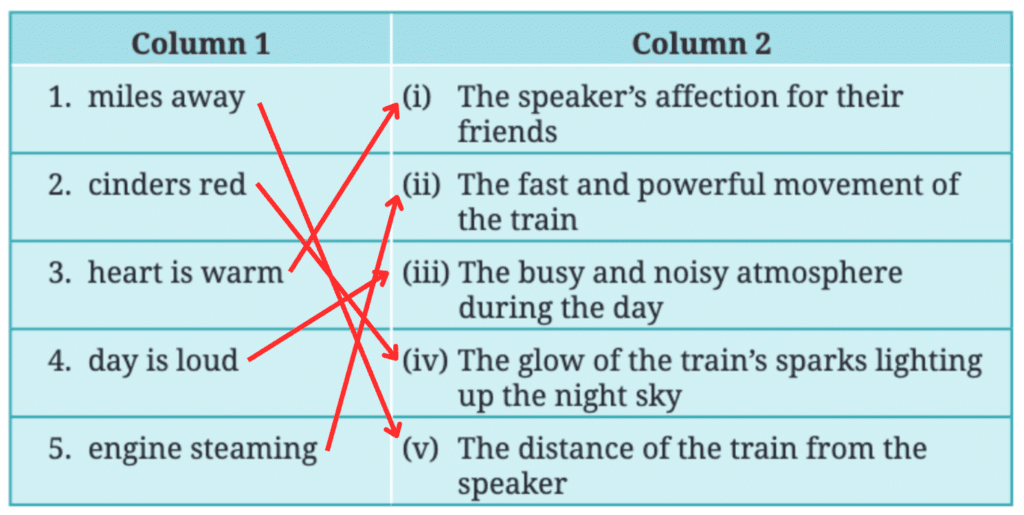
Now, use the expressions in Column 1 to fill in the following blanks correctly.
1. After meeting her old friend, her heart is warm with the joy of rekindled memories.
2. As I arrived at the railway station I could hear the engine steaming.
3. The marketplace is bustling, and the day is loud with the chatter of shoppers and vendors.
4. The bonfire glowed brightly, throwing cinders red into the dark night sky.
5. The sound of a train could still be heard miles away as the evening grew quiet.
QII: The poet uses the word 'shrieking' to tell us about the sound of the train's whistle. There are other words that tell us about different types of related sounds.
Read the meanings of such words in Column 1 and match them with the words in Column 2.
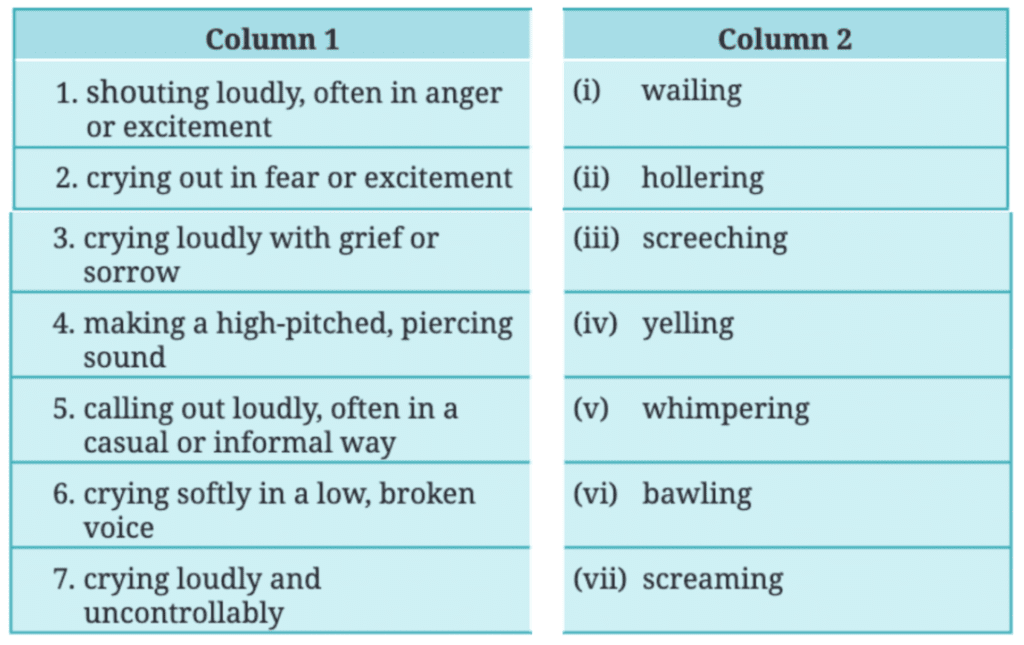
Ans:
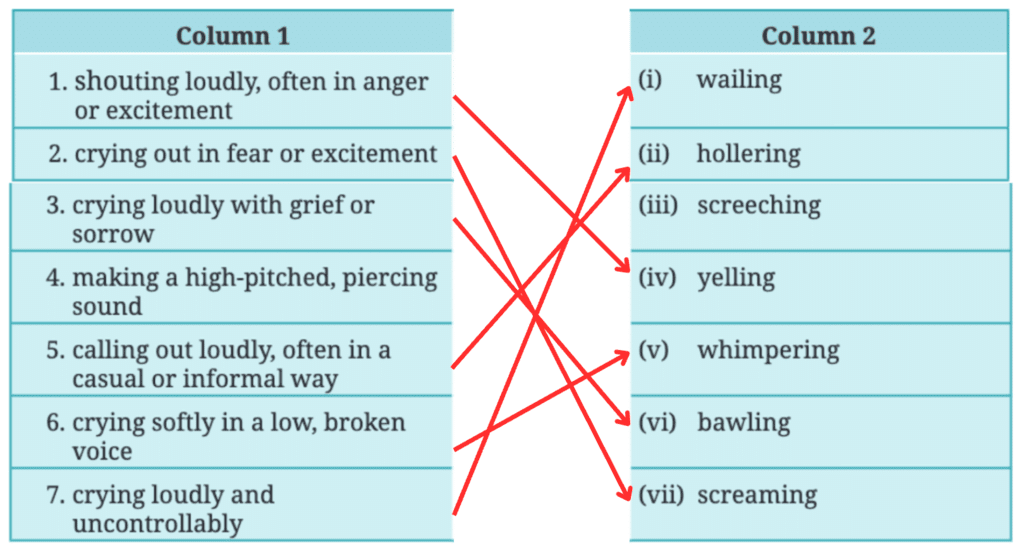
Now, complete the following paragraph by using suitable words from Column 2.
The street was filled with a variety of sounds. A shopkeeper was yelling to attract customers, while a child nearby was hollering at his friend to wait for him. From the other side of the road, a toddler was bawling uncontrollably after dropping his ice cream, and his mother tried to calm him as he began whimpering softly. In the background, someone's loud screaming voice added to the bustling noise of the busy evening.
Let us write (Page 165)
QI: A diamante poem is a poem that is shaped like a diamond, which uses specific types of words like adjectives and -ing words.

Let us now write a diamante poem that connects 'reading' and 'adventure'.
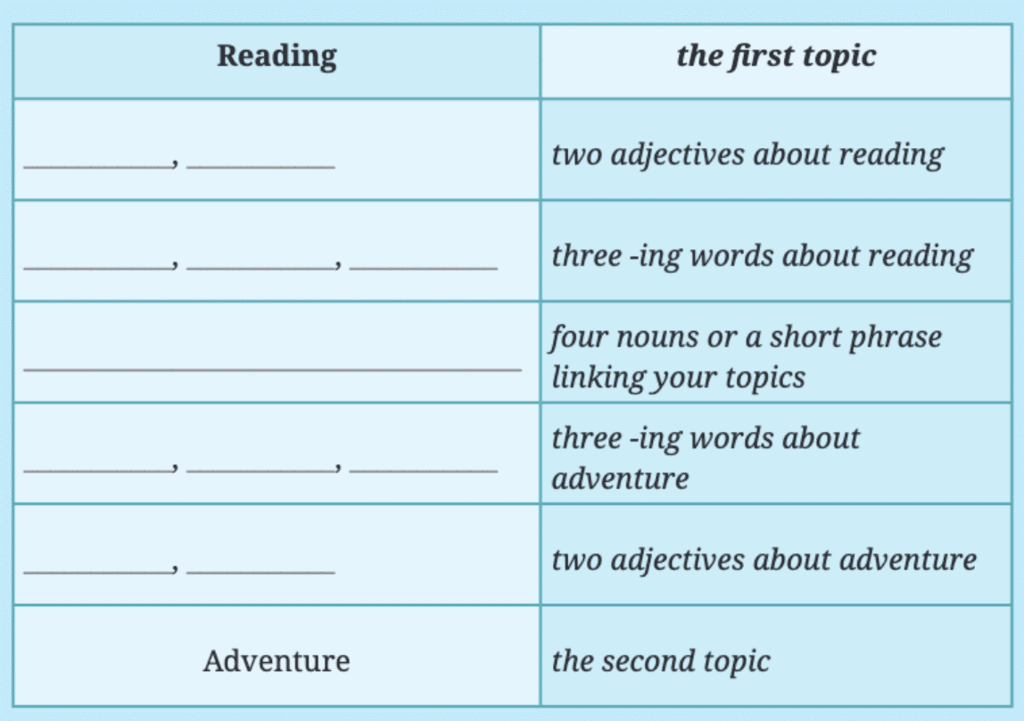
Ans:
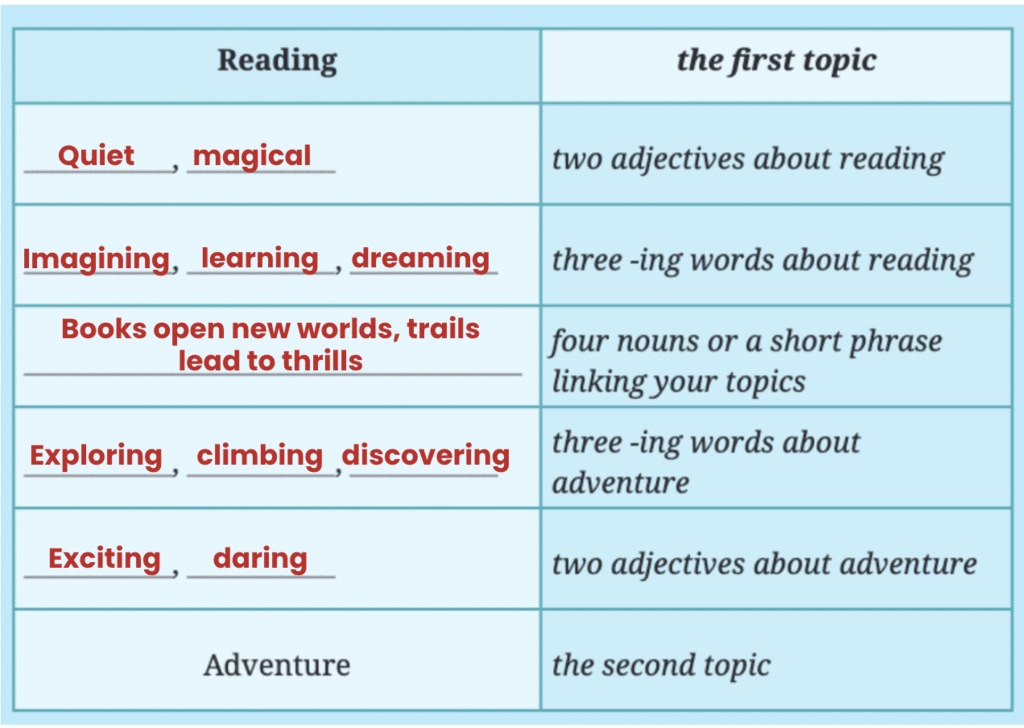
QII: We come across many interesting characters while travelling. They become interesting because of their actions, their behaviour, and manner of speaking. Describe one such character that you met.
Ans: I met a character named Mr. Ravi, a cheerful train conductor. He was tall with a big smile and wore a blue uniform. Mr. Ravi checked tickets and helped passengers with their bags. He was kind and funny, always telling jokes to make everyone laugh. I liked when he said, “This train is your magic carpet, enjoy the ride!” to a child.
|
55 videos|468 docs|76 tests
|
FAQs on NCERT Solutions for Class 7 English Unit 4 Travel
| 1. What are the key themes discussed in the chapter "Travel" from Class 7 NCERT? |  |
| 2. How does the chapter encourage students to appreciate different cultures while traveling? |  |
| 3. What are some tips provided in the chapter for planning a successful trip? |  |
| 4. Why is travel considered an important part of education according to the chapter? |  |
| 5. How can students make their travel experiences more meaningful? |  |




















